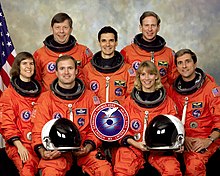 Columbia lands at Kennedy, following an abort of the mission due to a fuel cell malfunction | |
| Mission type | Microgravity research |
|---|---|
| Operator | NASA |
| COSPAR ID | 1997-013A |
| SATCAT no. | 24755 |
| Mission duration | Actual: 3 days, 23 hours, 12 minutes and 39 seconds Planned: 15 days and 16 hours |
| Distance travelled | 2,400,000 km (1,500,000 mi) |
| Spacecraft properties | |
| Spacecraft | Space Shuttle Columbia |
| Launch mass | 117,546 kg (259,144 lb)[1] |
| Landing mass | 106,724 kg (235,286 lb)[2] |
| Payload mass | 11,377 kg (25,082 lb)[3] |
| Crew | |
| Crew size | 7 |
| Members | |
| Start of mission | |
| Launch date | April 4, 1997, 19:20:32 UTC (14:20:32 EST) |
| Launch site | Kennedy, LC-39A |
| End of mission | |
| Landing date | April 8, 1997, 18:33:11 UTC (14:33:11 EDT) |
| Landing site | Kennedy, SLF Runway 33 |
| Orbital parameters | |
| Reference system | Geocentric orbit |
| Regime | Low Earth orbit |
| Perigee altitude | 298 km (185 mi) |
| Apogee altitude | 302 km (188 mi) |
| Inclination | 28.45° |
| Period | 90.5 minutes |

 Back row, from left: Crouch, Linteris and Gernhardt Front row: Voss, Halsell, Still and Thomas | |
STS-83 was a NASA Space Shuttle mission flown by Columbia. It was a science research mission that achieved orbit successfully, but the planned duration was a failure due to a technical problem with a fuel cell that resulted in the abort of the 15 day duration. Columbia returned to Earth just shy of four days. The mission was re-flown as STS-94 with the same crew later that year.
- ^ "NASA Historical Data Book, Vol. VII (Part 4)" (PDF). NASA. Archived (PDF) from the original on August 16, 2021. Retrieved August 16, 2015.
- ^ "STS-107 Mission Management Team (MMT) Minutes" (PDF). NASA. Archived (PDF) from the original on December 23, 2016. Retrieved August 16, 2015.
- ^ "NASA shuttle cargo summary" (PDF). NASA. Archived from the original (PDF) on August 31, 2000. Retrieved August 15, 2015.